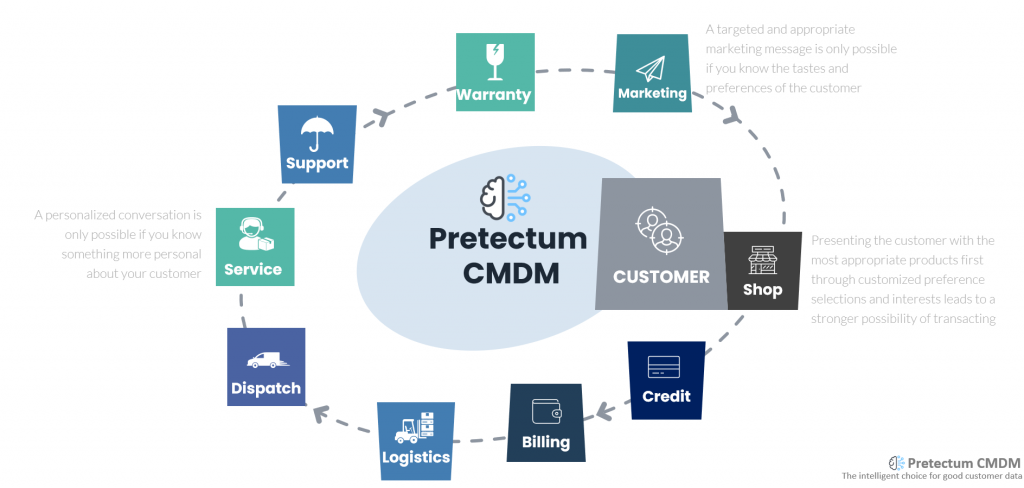There is a revolutionary potential impact accompanying the Pretectum CMDM (Customer Data Management) for businesses’ customer relationship management. Whether it be strategies, or tactics in customer data management, the opportunity cannot be overstated. The Pretectum CMDM cutting-edge system holds the potential to become your catalyst for organizational change, reshaping how your organizations approach customer lifetime value (CLV) and retention.

By seamlessly integrating your customer data systems and applying state-of-the-art technologies, Pretectum CMDM offers a comprehensive understanding of the customer, enabling organizations like yours, to make data-driven decisions that can profoundly influence your bottom line and organizational effectiveness.
Pretectum CMDM’s capabilities in enhancing customer lifetime value are truly exceptional.
By consolidating and analyzing data from numerous customer touchpoints, businesses gain invaluable insights into customer behaviour, preferences, and purchasing patterns. This deep integration allows organizations to tailor products and services to meet specific customer needs, fostering stronger and more meaningful relationships. Consequently, not only is the customer lifetime value extended, but it is also maximized, as businesses can leverage the platform to offer personalized experiences that resonate with customers on a profound level.
The system’s impact extends far beyond enhancing CLV; it plays a pivotal role in revolutionizing customer retention strategies too. Armed with sophisticated analytics and predictive modelling capabilities, Pretectum CMDM empowers businesses to embark on exercises to identify various characteristics of customers like “at-risk-of-churn” assessments, that can be undertaken early on and then support being able to implement proactive retention measures. Recognizing signs of dissatisfaction or potential churn enables organizations to take targeted actions, such as personalized communication, special offers, or loyalty programs, re-engaging customers and fortifying their loyalty to the brand.
An additional strength of Pretectum CMDM lies in breaking down silos within organizations. By centralizing customer data and making it accessible across various departments, such as marketing, sales, and customer service, Pretectum CMDM fosters collaboration and ensures a cohesive approach to customer management. This streamlined communication and shared understanding of customer information contribute to more effective and consistent retention strategies, creating a seamless experience for the customer across all touchpoints.

Despite its undeniable benefits, the implementation of Pretectum CMDM is not without its challenges. Data privacy concerns and the imperative need for robust cybersecurity measures are key considerations. However, organizations successfully navigating these challenges find themselves at the forefront of a customer-centric revolution, where the ability to harness data for personalized experiences becomes a crucial differentiator.
In addition to its impact on CLV and retention, Pretectum CMDM empowers businesses to stay ahead of market trends. Through the use of comprehensive search in support of advanced analytics and real-time data processing, organizations can swiftly adapt their strategies to changing customer preferences and market dynamics. This agility is critical in maintaining a competitive edge and ensuring that customer retention efforts remain relevant in an ever-evolving business landscape.
The transformative potential of Pretectum CMDM becomes especially evident when considering its role in creating a more agile and adaptive business environment. The system’s ability to provide real-time insights into customer behaviour allows organizations to make informed decisions swiftly. This agility is a game-changer in today’s dynamic markets, where the ability to pivot strategies based on evolving customer expectations is crucial for sustained success.
Pretectum CMDM can also act as a catalyst for other kinds of innovation within organizations. The wealth of customer data at an organization’s disposal enables it to identify untapped opportunities, innovate products and services, and deliver unique value propositions to customers when the data is all collated within the platform. By leveraging the power of data, businesses can not only meet but exceed customer expectations, thereby solidifying their position in the market and enhancing customer loyalty.

One cannot discuss the impact of Pretectum CMDM without acknowledging its role in fostering a customer-centric culture. The system encourages organizations to prioritize customer needs and preferences by providing a holistic view of customer interactions. This shift towards customer-centricity is not just a strategic advantage but a fundamental shift in how businesses perceive and engage with their customers. It underscores the importance of building relationships beyond transactions, creating a loyal customer base that forms the backbone of sustained business success.
As organizations continue to embrace the capabilities of Pretectum CMDM, the landscape of customer relationship management is undergoing a profound transformation. The traditional one-size-fits-all approach is giving way to personalized, targeted strategies that resonate with individual customers. The ability to treat customers as unique individuals with distinct preferences and behaviours is becoming a hallmark of successful businesses in today’s competitive landscape.


